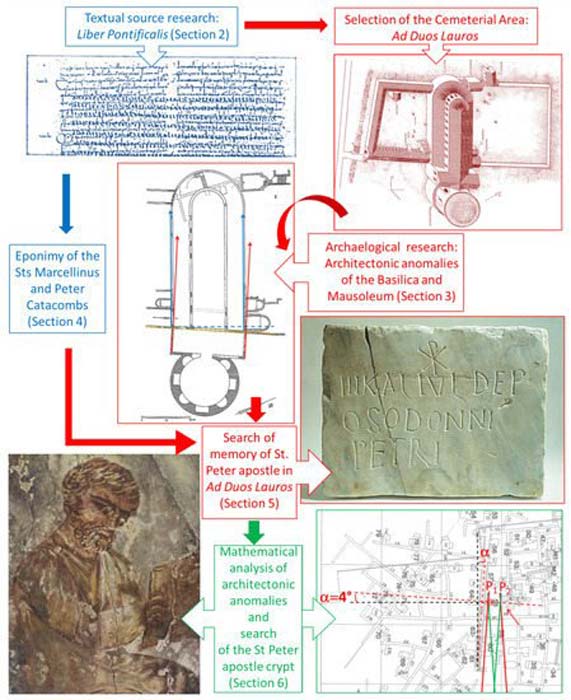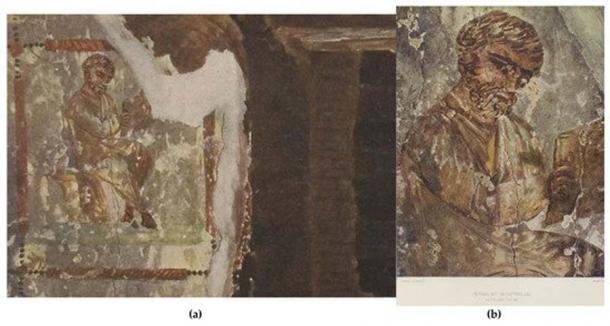Saint Peter, born a Jewish man, was one of the twelve Apostles of Jesus Christ. He is also historically recognized as the first Pope in Christianity. In Catholic legends, he is seen as the first recipient of the keys to the gates of the Kingdom of Heaven. Under Emperor Nero, at a time when the Christian faith was under persecution from the pagan Roman state, St. Peter was sentenced to death by crucifixion at Vatican Hill.
Tradition states that the Basilica of St. Peter, a stunning church built in Renaissance-style architecture in the 16th and 17th centuries, within Vatican City, is the resting place of St Peter’s final remains. The basilica was designed by Donato and Michelangelo, amongst others, and is the largest church in the world (interior measurement) and the holiest of Christian shrines. Three Italian researchers now “have expressed doubt as to whether the bones of St. Peter actually lie beneath the Roman Basilica named in his honor,” according to Aleteia.

Planning of the research to solve the mystery of where St Peter’s final remains are buried. At the top left corner an image of the folio 42v of the Manuscript IV.A.8 of the Liber Pontificalis. The other images of the figure are explained in the indicated sections. ( Heritage journal )
St. Peter’s Remains May Lie Under the St. Helena Mausoleum
The research into the true location of St. Peter’s remains , led by Liberato de Caro of the National Research Council of Italy, was published in the Heritage journal in March 2021. The researchers made this claim after studying the Depositio Martyrum , a document published during the reign of Emperor Constantine (306-337 AD). This important document does not mention St. Peter’s purported resting place under the Basilica on Vatican Hill.
As expected, a member of the Pontifical Commission of Sacred Archaeology (the official board of the Vatican Church), has termed this conjecture “unacceptable.”
Vincenzo Fiocchi Nicolai, an expert in Christian archaeology and a member of the Commission, told Vatican News Emperor Constantine would not have built the basilica there in St Peter’s honor, “if it had not been contingent upon the presence of the venerated remains.” He continued, “It is clear that Peter’s remains were found in the place of the original burial site on the Vatican hill when the formidable Constantinian basilica was built, the biggest basilica ever established in the city.”
Although not conclusive, the researchers’ findings indicate that St. Peter’s remains were shifted from the Vatican Hill during the 3 rd century AD, due to rampant Christian persecution . They claim his remains are in fact housed under the domed structure known as the Mausoleum of St. Helena, but caution that an archaeological excavation must be conducted first to prove their theory.
In 1968, the bones of a 60–70-year-old robust male were discovered, and Pope Paul VI announced that these remains were convincing enough to convince the clergy that it was St. Peter.

Detail of Figure no. 93 published in. It shows a watercolor of St. Peter’s fresco found in cubicle no. 58 of the catacombs of the Saints Marcellinus and Peter. (b) Detail with the legend “Peter with scroll” (Petrus Mit Schriftrolle). ( Heritage journal )
The Roman Empire and its Relationship with Christianity
Contrary to popular belief, the spread of the Roman Empire , founded on the ideals of paganism and the Hellenistic religion, was met by stiff resistance from the Christian faith, which was rapidly spreading across Europe. Traditional Roman religion, which was polytheistic and believed in rituals like animal sacrifices, was looked down upon by the Christians, who were not practitioners of idolatry and had a value system antithetical to the imperial cult of ancient Rome.
On the basis of suspicions and rumors, Christians were persecuted and tried for treason both by the state and civic society. However, the march of time could not stop the widespread expansion of the Christian faith.
The tables would be turned in the later stages of the Roman Empire, particularly after the Edict of Thessalonica in 380 AD affirmed Christianity’s status as the official state church of the Roman empire. History had turned everything upside down as the late Roman Empire was rife with examples of the very opposite happening to pagans and non-Christians, including stigmatization and violence.
In the midst of all of this, Rome overtook Antioch, Alexandria, Constantinople and Jerusalem (in chronological order) to become the central city of the Christian faith. This Rome-focused reputation of the Christian faith was built on the tradition that St. Peter and St. Paul were martyred and crucified in the city in the 1 st century on the orders of Emperor Nero .
In fact, the Bishop of Rome, Linus, would go onto proclaim himself as St. Peter’s successor (he was recognized as the second Pope in Christian history). From this point onward, Pope Linus would go onto recognize himself as the overarching authority over all other bishops, and over all practitioners of Christianity. His papacy officially commenced in 67 AD and would last unto his death in 76 AD. Pope Linus, like Saint Peter, is also believed to have been buried on Vatican Hill.
Top image: Statue of Saint Peter in Vatican city, Italy. The mystery of where St Peter’s remains are actually buried continues as a new research paper questions previous evidence. Source: Savvapanf Photo © / Adobe Stock
By Rudra Bhushan
Related posts:
Views: 0
 RSS Feed
RSS Feed















 June 8th, 2021
June 8th, 2021  Awake Goy
Awake Goy  Posted in
Posted in  Tags:
Tags: 
















